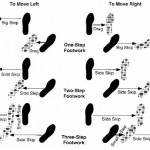
By Barry Gasson
In the world of Ballroom Dancing, there are literally millions of variations, steps, figures, choreographic highlights, trick-steps etc.
None of them come remotely close to the importance of the right foot walk, or more importantly, the differences that exist between the right foot walks when performed in different dances.
The right foot walk is the most used step in the Waltz and Foxtrot, it is the first step of the Natural Turn in the Waltz and the Feather Step in Foxtrot. They are similar in that they carry and deliver the bodyweight onto the right foot, but they differ in many respects, and these differences are worthy of discussion and understanding.
They differ in step length, body rotation, duration in time, body poise, speed of foot placement and knee usage at end of step.
The Waltz is based on a semi-sideways movement that ends in at foot closure at the culmination of rise. The Foxtrot employs rotation in principle to create a side lead in order to step outside partner and pass the feet.
Therefore, one would not mention CBM in a Waltz, in fact, at the end of the walk the right side should still be in advance of the left side, whereas in Foxtrot the desire to rotate will result in the left side being in advance.
In a very refined sense, this desire to pass the feet will affect body poise. The weight will be held slightly further forward in Foxtrot.
Note: Such is the subtlety and complexity of the English language I refrain from saying that the Waltz will have a slighter more backward poise than the Foxtrot. That would give a different meaning, and the word backward is best left out of the equation.
The Waltz swing action is a quick — developing slow. I want to take the walk swiftly so as to leave more music at the end of the bar to perform the foot closure involving deceleration. So the foot is placed with no great feeling of extension. It is the same placement of foot that a soccer player uses when taking a kick at a stationary ball. The foot is placed alongside the ball to be kicked, underneath the body.
On the other hand (sorry, foot) the Foxtrot walk is a slow — developing quick. The right foot is not placed, it will be measured and will extend further as the stride is taken. Hence, the well known phrase, ‘Measure the slow and swing two quicks,’ to describe the Foxtrot swing over a bar of music
Another important factor is the time duration of the step. If both dances are at a tempo of 30 bars per minute, the walk in Waltz will take one third of a second, the walk in the Foxtrot will consume one half of a second. The difference, one sixth of a second, is not very much, but it is significant, and enables the extension.
When weight has been taken on to the right foot, a further difference is apparent. In Waltz the right knee will continue to move forward and a commencement of rise occurs as the right thigh moves over the right knee and foot. If this were not to happen the dancer would be performing “lower—lower”, as a commencement of rise would not be possible.
In Foxtrot, with its’ earlier rise, the knee will move on but the knee will start to straighten. This straightening of the knee will be more abrupt if a turn is to be made and the lady is to dance a heel turn.
The right foot walk in Tango differs considerably in several respects.
Due to the more enveloping hold, the right foot walk is performed with a side lead and follows the curved line of the previous left foot walk.
The weight does not move from heel through ball to toe, but moves across the foot in the region of the toecap. This will involve the use of the inside and outside edges of the foot.
Additionally, when dancing the right foot walk in Tango the right foot will not travel under the right hip, it will take a path of travel outside the line of the right hip
Of course, there is no rise in Tango, but more and more the younger couples are employing rise and involving swing action. Couple this disturbing trend with walks that do not curve, and a less enveloping hold that doesn’t employ a right side lead, and the Tango is in grave danger of being unrecogniseable. Were it not for the sharp head actions it would be hard to identify the Tango at first sight.
Unfortunately, the art of Tango is becoming more obscure as so many of today’s dancers use a Foxtrot walk, and do not use the Tango curvature of movement.
The study and understanding of the walk actions in the Waltz, Tango and Foxtrot should be the subject of continuous study and revision.
All champions, whether of today or of yesteryear, have to return to a study of the walk actions that apply in each dance.
Barry Gasson









